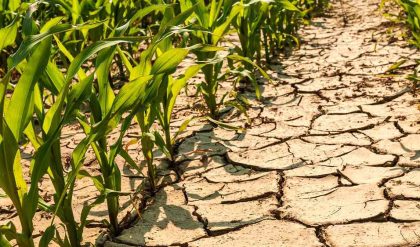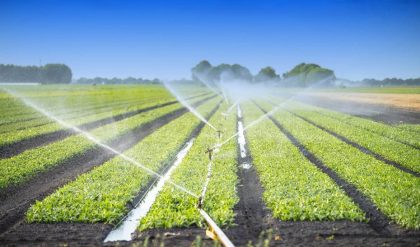Introduction
All soils initially come from rocks, this is termed the ‘parent material’. The Parent Material may be directly below the soil, or great distances away if wind, water or glaciers have transported the soil. In addition to the soil parent material, soil formation is also dependent upon other prevailing processes affecting soil formation. The soil formation process is termed ‘pedogenesis’. Climatic conditions are important factors affecting both the form and rate of physical and chemical weathering of the parent material. The formation of soils can be seen as a combination of the products of weathering, of structural development of the soil, of differentiation of that structure into horizons or layers, and lastly of its movement or translocation. In fact there are many ways in which soil may be transported away from the location where it was first formed.

In the UK, one of the most important of these factors is the effect that the ice ages have had. As glaciers pushed southwards down the country, they acted like giant bulldozers pushing soil ahead of them. Glacial ‘till’ or ‘drift’ deposits resulted many tens or even hundreds of miles from where the soils were first formed. When the weather warmed up and the glaciers melted, great mounds of soil were left behind, these are called ‘moraines’ and can be very impressive to see – clearly demonstrating the power of glaciers. Water is also very important in moving soils. As rivers flow, so they transport soil particles along. If soil is washed into a river, the smallest particles will be carried the furthest by the water as they weigh the least. Heavier particles, such as sand, will be dropped earlier by the river. If you see an aerial photograph of a river as it flows into the sea or a lake, you may see the ‘fan’ of deposited soil materials. Soils deposited in this way around lakes and rivers are termed ‘alluvial’. Soils deposited in lakes are called ‘lacustrine’, soils deposited by rivers ‘riverine’ and by sea ‘marine’ alluvial soils.
 Rainfall is also important in washing soil off exposed land. Even gentle rain can dislodge and move small soil particles. If this happens all across a field the process is termed ‘sheet erosion’.Where there is a lot of rain, small gulleys can form which can speed up the process of ‘gulley erosion’. In tropical countries where there is extremely heavy rain, these gulleys can become so deep that you can walk down into them. Farmers should be aware of the effects of erosion upon their soil resource. Fields on slopes should be ploughed in lines across the gradient to prevent excess runoff and erosion. However, one can often see fields ploughed down the slope. This has the effect of creating small channels for rain water, and these channels can soon enlarge.
Rainfall is also important in washing soil off exposed land. Even gentle rain can dislodge and move small soil particles. If this happens all across a field the process is termed ‘sheet erosion’.Where there is a lot of rain, small gulleys can form which can speed up the process of ‘gulley erosion’. In tropical countries where there is extremely heavy rain, these gulleys can become so deep that you can walk down into them. Farmers should be aware of the effects of erosion upon their soil resource. Fields on slopes should be ploughed in lines across the gradient to prevent excess runoff and erosion. However, one can often see fields ploughed down the slope. This has the effect of creating small channels for rain water, and these channels can soon enlarge.
 One way scientists can try to quantify the effects of such erosion is to employ dye tracers in the field. To do this, during a rain event, a dye tablet is placed in the field and the extent of the resulting runoff pattern then becomes only too clear.
One way scientists can try to quantify the effects of such erosion is to employ dye tracers in the field. To do this, during a rain event, a dye tablet is placed in the field and the extent of the resulting runoff pattern then becomes only too clear.
The wind is also able to move surprisingly large quantities of soil. On occasions fine soil deposits can be seen in many parts of the South of England which have been blown all the way from North African deserts.
Soil in your garden is likely to be well mixed both as a result of years of digging and from the activities of animals in the soil such as worms. In agricultural fields there may be less mixing as there are fewer animals present due to the use of chemicals and compaction from heavy machinery. Ploughs are used to aerate and mix the soil instead. Where ploughs are continually used at a certain set depth, there may form a hard layer called a ‘pan’ below which there is little mixing. Such hard pans can also affect the drainage in the field where water cannot flow downwards affecting crop yields.
Weathering Processes
One important influence on the formation of soils is weathering. There are two main categories of weathering, both having different effects:
Physical Weathering
• Freezing and Thawing – here, the expansive force of water pushes the soil structures apart. Water expands considerably when frozen and this expansion literally pushes the soil apart, breaking it down. When the ice thaws the soil can slump back again. The overall process is rather like a very slow ‘churning’. Freeze-thawing can literally grind mountains down over time!
• Heating and Cooling – here soils subjected to extremes of temperature are affected as they expand and contract. The effect is less pronounced that that of freezing and thawing but over time this can become significant.
• Wetting and Drying – soils that are wetted up may be prone to swelling. Clay minerals in particular exhibit this property. The soils that have thus expanded then shrink when the soils dry out. These seasonal effects are termed shrinkage and swelling. Many household claims for subsidence are based upon such shrinkage and swelling of clays under foundations.
• Grinding or Rubbing – most obvious on the beach, grinding of particles against each other leads to particle disintegration. This is why beach pebbles become smooth. Abrasion similarly breaks down the soil particles.
•Organisms – the effect of organisms, plants and animals, living in the soil cannot be overstated. Soil is home for a wide range of organisms. If plants can push through concrete – soil presents little obstacle! Worms churn their way through soil, mixing and aerating it all through their lives and there can be thousands of worms in a field.
• Unloading – when pressure is placed upon soil it becomes compressed. Never mind tractors, imagine the weight of a glacier! When ice melts a huge weight is lifted and the soils may react accordingly by uplifting and expanding.
Chemical Weathering
•Solution – certain solid components in the soil can be dissolved in soil water. In this way underground caverns can form in limestone karst landscapes. The name Karst comes from the Krass plateau in Slovenia where there are some of the most magnificent cave systems anywhere in the world – valley sized caves!
•Hydrolysis – certain compounds in the soil can react to elements in the water.
•Carbonation – soil compounds can react with carbonic acid.
•Hydration – water in the soil can act to change the chemical structure of the soil components.
•Oxidation – oxygen in the soil can act to change the chemical structure of the soil components.
•Reduction – a lack of oxygen in the soil can act to change the chemical structure of the soil components
Soil Forming Processes
There are five key processes by which soil is formed, they are:
Leaching – leaching is the removal of soluable components of the soil column. As water washes down through the soil it can carry away bases such as calcium, held as exchangeable ions in clay-humus complexes, as well as acidification through the substitution of hydrogen ions.
Eluviation – here soil particles held in suspension, such as clay, are removed (eg. washed away).
Illuviation – here soil particles held in suspension, such as clay, are accumulated (eg. deposited).
Podsolisation – podsolisation occurs when strongly acid soil solutions cause the breakdown of clay minerals. As a result silica, aluminium and iron form complexes with organic substances in the soil. These minerals are removed from the surface zone of the soil and can accumulate in distinct dark sub-surface layers – very evident on inspection. Upland heaths and moors often contain podsols.
Gleying – gleying occurs in waterlogged, anaerobic conditions when iron compounds are reduced and either removed from the soil, or segregated out as mottles or concretions in the soil. Marshy wetlands often contain gleyed soils.
It is important to realise also that soil types are closely related to the shape of the landscape – or its ‘topography’. Soil scientists use this to help them create soil maps. An experienced eye can determine changes in underlying soil types when walking through a landscape and observing changes in topography (and often vegetation too).

Soil Structure
All the effects of soil forming processes, weathering, translocation leaching and so on leave the soil with a particular ‘structure’. Soil structure refers to the shape, size and degree of development of the aggregation, if any, of the primary soil particles into naturally or artificially formed structural units and to their spatial arrangement. In describing soil structure, we refer to soil ‘peds’ and soil fragments or ‘clods’. Soil peds are natural, relatively permanent aggregates, separated from each other by voids or natural surfaces of weakness. Peds persist through cycles of wetting and drying. Soil Fragments and Clods are artificial structural units, formed at or near the surface by cultivation or frost action, and are not peds.
Degradation of soil structures occur by a number of manners including:
• Slaking – the breaking down of aggregates by rain impact or under wet conditions; sorting soil particles and washing them into depressions – such slaking can form surface crusts or caps hindering shoot emergence in young crops. The winter of 2002 in the UK saw many fields in the South East becoming ‘capped’ by the intense pounding of rain on the soil surface – which dramatically affected subsequent soil water runoff.
• Cementation – in certain cases, a subsoil iron ‘pan’ or hard ferrous layer can form, effectively preventing root penetration. Iron pans can be surprisingly hard, and if dug out can be held up and may need to be ‘snapped’ to break them!
• Sodium leaching – as saline soil solutions are diluted, sodium-saturated clays become unstable causing clay deflocculation and structural collapse.
• Cultivation – the downward compression from machinery when the soil is too ‘plastic’ can form a barrier to rooting and drainage as massive or platy structures form. This emphasises the need for the correct design of vehicles designed to work the soil. The following picture highlights a highly compressed soil, with a massive structure showing horizontal fracturing and stressed roots. So called ‘plough pans’ can also form if a plough of a set depth is used over and over again year after year. Where this happens a hard layer of soil can build up just under the depth of the plough. This hard layer can impede field drainage and adversely affect crop yield.





